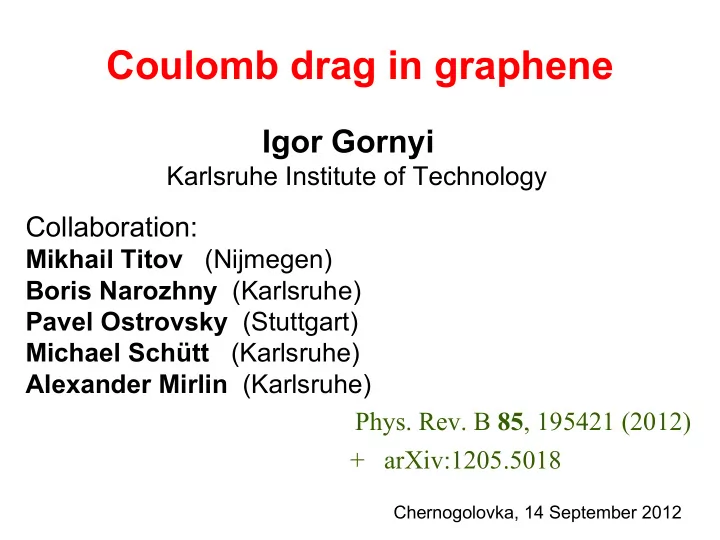

Coulomb drag in graphene Igor Gornyi Karlsruhe Institute of Technology Collaboration: Mikhail Titov (Nijmegen) Boris Narozhny (Karlsruhe) Pavel Ostrovsky (Stuttgart) Michael Schütt (Karlsruhe) Alexander Mirlin (Karlsruhe) Phys. Rev. B 85 , 195421 (2012) + arXiv:1205.5018 Chernogolovka, 14 September 2012
What is Coulomb drag? Coulomb drag = response of the passive layer to a current in the active layer mediated by Coulomb interaction
Coulomb drag measurements Gramila, Eisenstein, MacDonald et.al ., Phys. Rev. Lett. 66, 1216 (1991)
Theory: 2D Pogrebinskii (1977) – introduced Coulomb drag Zheng, MacDonald (1993) – memory function Jauho, Smith (1993) – kinetic equation Kamenev, Oreg (1995) – diagrammatics Flensberg et al. (1995) – diagrammatics ...
Coulomb drag: why interesting? • no drag without interaction: probe of inter-electron correlations • provides information about inelastic processes, phase-coherent phenomena • drag is related to particle-hole asymmetry Drag in graphene near the Dirac point ?
Particle-hole asymmetry Example: strong magnetic field (i) Curvature normal positive drag (ii) Landau levels DoS anomalous oscillatory drag IG, Mirlin, von Oppen (2004)
Drag in 2D: standard theory
Drag in graphene
News in graphene Dirac spectrum at low energies electron-hole symmetry at the Dirac point linear spectrum – no Galilean invariance non-trivial single-layer conductivity – small interlayer distance d
Drag in graphene: experiment single-gate device Kim, Jo, Nah, Yao, Banerjee, and Tutuc, Phys. Rev. B 83 , 161401 (2011)
Drag in graphene: experiment single-gate device Kim, Jo, Nah, Yao, Banerjee, and Tutuc, Phys. Rev. B 83 , 161401 (2011)
Drag in graphene: experiment double-gate device Tutuc and Kim, Solid State Comm. (2012)
Drag in graphene: experiment double-gate device Tutuc and Kim, Solid State Comm. (2012)
Drag in graphene: experiment Gorbachev, Geim, Novoselov, Ponomarenko et al. ArXiv:1206.6626 “clean” – substrate and spacer – BN smaller inter-layer spacing – d = 1-10 nm - Double-gate setup:
Drag in graphene: experiment double-gate device Gorbachev, Geim, Novoselov, Ponomarenko et al. ArXiv:1206.6626
Drag in graphene: experiment double-gate device Gorbachev, Geim, Novoselov, Ponomarenko et al. ArXiv:1206.6626
Drag in graphene: experiment double-gate device Gorbachev, Geim, Novoselov, Ponomarenko et al. ArXiv:1206.6626
disordered graphene
Second-order perturbation theory Narozhny, Titov, IG, and Ostrovsky, PRB (2012) non-linear susceptibility screened interlayer (rectification function) interaction
Drag in disordered graphene controlled perturbation theory weak interaction – qualitatively not important: – plasmons • dominant scattering mechanism – static screening is sufficient is due to disorder spectrum renormalization • energy dependence of disorder • arbitrary values of chemical scattering time potential experimental condition non-degenerate Fermi relativistic gas liquid
comparison with experiment courtesy of L. Ponomarenko
ultra-clean graphene
Graphene: no Galilean invariance, relativistic dynamics
Clean vs. disordered graphene
Kinetic theory of the drag Linearized kinetic equation:
Inelastic scattering in graphene Kashuba '08, Fritz, Müller, Schmalian, Sachdev '08 Linear spectrum: Velocity is not equivalent to momentum: momentum conservation does not prevent current relaxation - Finite transport rate due to inelastic e-e scattering Collinear scattering singularity: momentum conservation = energy conservation - Fast thermalization within a given direction
Collinear scattering singularity
Double-layer graphene Only two modes (velocity and momentum) in each layer: Fast unidirectional thermalization between layers: Kinetic (integral) equation reduces to a 3x3 matrix equation! Hydrodynamics: total momentum + particle currents
Hydrodynamic equations
Scattering rates: Golden Rule close to the Dirac point away from the Dirac point
Drag resistivity Equal layers: Non-equal layers near the Dirac point Finite drag at the Dirac point in the clean case!
neutrality point
Drag rate: beyond Golden Rule Exactly at the Dirac point: finite third-order drag
Diffusive regime Conventional (second-order) drag vanishes at the Dirac point Third-order (Levchenko & Kamenev 2008) drag dominates
Correlated disorder Correlated elastic scattering in the two layers with common impurities Ballistic regime: Diffusive regime: interlayer Cooper mode (IG, Yashenkin, Khveshchenko '99)
Correlated disorder Correlated elastic scattering in the two layers with common impurities Moderately correlated disorder:
2 nd vs. 3 rd order drag
Drag at the Dirac point
Magnetodrag Gorbachev, Geim, Novoselov, Ponomarenko et al. ArXiv:1206.6626
Summary Coulomb drag in graphene: - Perturbation theory - Kinetic theory (3 mode hydrodynamics) - Clean graphene (equilibrated drag) - Peak at the Dirac point 3 rd order drag, drag with correlated disorder
Recommend
More recommend